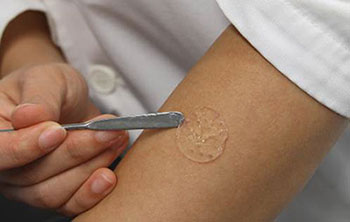| May 16, 2014 |
Nanogel heals burn wounds faster
|
|
(Nanowerk News) Researchers at the Institute of Bioengineering and Nanotechnology have developed a nanogel that can accelerate the healing of burn wounds to minimize the risk of infection and scarring. The technology is based on IBN’s proprietary self-assembling ultrashort peptide technology, which are short sequences of amino acids.
|
|
“There is currently no commercial dressing available that can treat burn wounds rapidly. Our peptide hydrogel targets second to third degree burn wounds and fills a niche neglected by existing treatment options,” said IBN Executive Director Professor Jackie Y. Ying.
|
|
For second to third degree burns, the top (epidermis) and underlying (dermis) layers of the skin are destroyed, leaving very few viable skin cells for regeneration. Recovery using standard wound treatment could take between 2 to 10 weeks. The likelihood of scar formation and infection increases when the healing duration is prolonged.
|
|
In a recent study published in Biomaterials ("Ultrashort peptide nanofibrous hydrogels for the acceleration of healing of burn wounds"), the IBN researchers found that the peptide hydrogels can promote skin regeneration by acting as a scaffold for skin cells to grow. When water is added, the peptides self-assembled into nanofibers that entrap water to form a fibrous gel, which resembles the extracellular matrix.
|
 |
| The IBN nanogel may be commercialized as a membrane patch for faster healing of burn wounds.
|
|
Extracellular matrix is an integral component of skin tissue, which provides the mechanical and structural support for cells in the human body. Rich in moisture and porous, the peptide-based hydrogels provide the extracellular matrix-like environment for skin cells to grow.
|
|
IBN’s nanogel can heal burn wounds much faster than the silicone-based wound dressing currently used in clinics. In animal studies, IBN’s hydrogels achieved close to 100% wound closure after just 2 weeks compared to silicone dressing, which only healed 63% of the injured area.
|
|
This work builds on the ultrashort peptides discovered in 2009 by Dr Charlotte Hauser, IBN Team Leader and Principal Research Scientist. The aliphatic peptides were designed using much fewer amino acids compared to existing self-assembling peptides. Non-immunogenic and non-toxic, the peptides are ideal for a variety of biomedical applications.
|
|
“Ultimately, we hope to develop a gel that can incorporate bioactive agents to further enhance skin regeneration. Our peptides could also be used to develop synthetic skin substitutes for deeper burns,” said Dr Hauser.
|
|
This work was conducted in collaboration with the DSO National Laboratories, which was interested to develop rapid and first-line treatment of soldiers injured in blasts, and the National University Hospital, which established the animal model for preclinical validation of the hydrogels.
|
|
If commercialized, IBN’s new hydrogels could be manufactured as a membrane patch, topical gel or spray. The research team is also looking into a dry-powder formulation, in which the gel can be activated by just adding water. Such a product would have a longer shelf-life and could be included in first aid kits for wound care therapy.
|
|
IBN researchers have also investigated the use of these ultrashort peptides for other therapies such as the treatment of Alzheimer’s, cancer and degenerative disc disease. The peptide-based technology has recently been licensed to 3-D Matrix Asia Pte. Ltd. for bone regeneration and drug delivery systems in orthopedic surgery.
|

